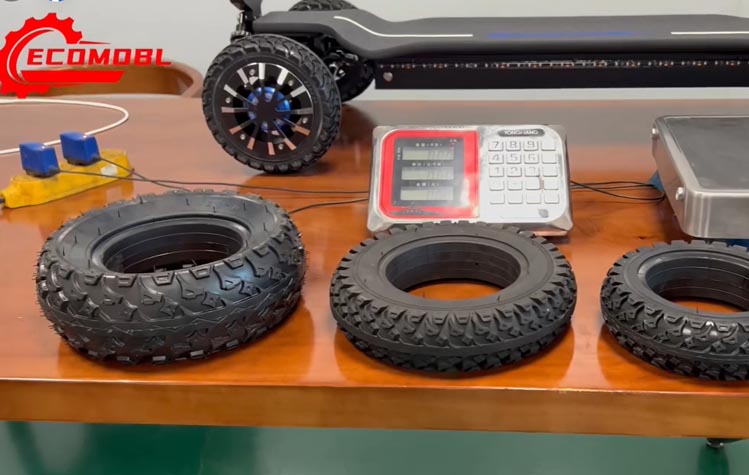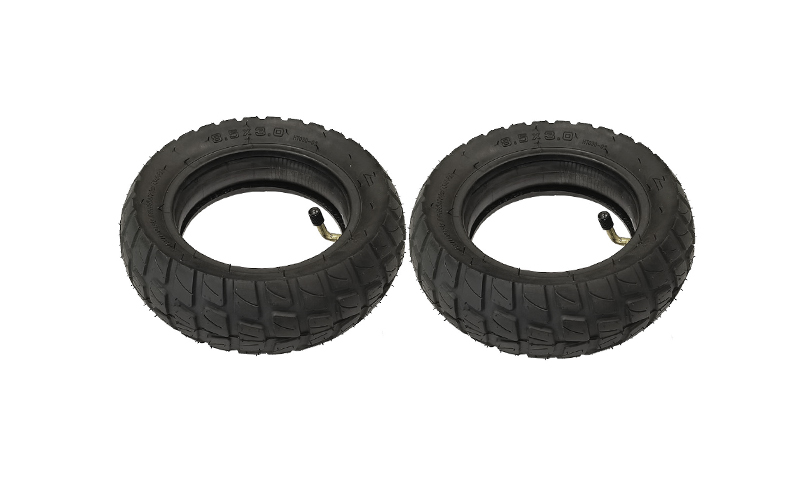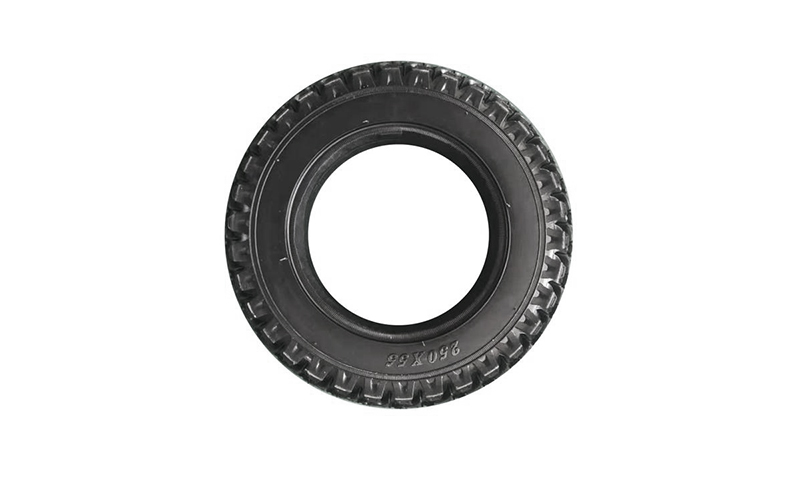Choosing between airless and pneumatic tires is one of the most impactful decisions you can make when riding an electric skateboard, especially electric models like the Ecomobl M24 and M24 Pro.
Your tire choice influences everything from ride comfort and traction to battery efficiency and maintenance needs.
This comprehensive guide breaks down the strengths and weaknesses of both tire types, helping you select the setup that aligns with your terrain, riding style, and performance expectations.
What Are Airless and Pneumatic Tires?
Pneumatic tires are traditional air-filled rubber tires that provide natural shock absorption. They’ve long been the standard thanks to their flexibility and adjustable performance.
Airless or non-pneumatic tires, on the other hand, are made from solid rubber or polymer foam. They don’t require inflation; the tire’s internal structure and material compression deliver support and impact absorption.
Airless Tires: Detailed Breakdown
Advantages
1. Extreme Puncture Resistance
Airless tires are immune to flats from thorns, glass, nails, and sharp debris, making them perfect for rugged forest trails, construction-zone paths, and off-road areas with hidden hazards.
2. Zero Maintenance
No pumps, no pressure checks, no patch kits. Airless tires stay consistent without daily upkeep.
3. Better Cold-Weather Dependability
Cold temperatures reduce air pressure inside pneumatic tires, but airless tires maintain consistent performance even near or below freezing.
4. Terrain Durability
Ideal for thorny forests, roots, and rocky ground. They continue performing even under conditions that commonly puncture pneumatic tires.
5. Long-Term Wear
Airless tires usually last longer under harsh conditions, offering more value over time despite a higher upfront cost.
Drawbacks
1. Added Weight
Airless tires are significantly heavier, requiring more motor power to accelerate and reducing the total range on electric mountain boards.
2. Balance and Wobble Issues
Manufacturing inconsistencies can cause slight imbalances, resulting in wobbles at certain speeds. This instability can affect stance control and rider confidence, especially on high-speed electric boards.
3. Harsher Ride
Without an air cushion, more vibrations are transmitted to the deck and rider, increasing fatigue on longer rides.
4. Heat Buildup
Higher rolling resistance generates heat during high-speed or long-distance rides, impacting efficiency.
5. Fixed Performance
You cannot tune the tire by adjusting air pressure, limiting customization for different surfaces.
Pneumatic Tires: Detailed Breakdown

Advantages
1. Superior Ride Comfort
Air acts as a natural suspension system, smoothing out bumps and reducing vibration. This works similarly to skateboard bushings that provide controlled turning and impact absorption.
2. Adjustable Performance
Increase pressure for fast pavement riding; decrease it for soft sand, grass, or loose soil. This flexibility makes pneumatics ideal for riders who encounter multiple terrain types.
3. Lightweight Construction
Better acceleration, improved handling, and noticeably increased battery efficiency on electric mountainboards.
4. Better Heat Management
Lower rolling resistance helps dissipate heat more effectively during extended high-speed riding.
5. Excellent Traction
With proper pressure, pneumatic tires provide superior grip on dirt, pavement, gravel, and off-road surfaces.
Drawbacks
1. Vulnerable to Flats
Sharp sticks, nails, and rocks can cause punctures, forcing riders to stop and repair mid-ride.
2. Ongoing Maintenance
Frequent pressure adjustments and checks are essential, especially for long rides or temperature shifts.
3. Temperature Sensitivity
Air pressure fluctuates with ambient temperature, requiring more frequent monitoring.
4. Additional Gear Required
A pump, patch kit, or spare tube is recommended for longer trips.
Performance Comparison Across Terrain

City / Pavement
-
Pneumatic Tires:
Smooth, controlled carving with low rolling resistance is ideal for commuting and high-speed stability. -
Airless Tires:
More vibration and potential wobble at mid-to-high speeds.
Off-Road / Forest Trails
-
Pneumatic Tires:
Better traction and comfort with pressure adjustments for rocks, roots, and soil. -
Airless Tires:
Excellent durability, but heavier and less agile.
Muddy or Wet Conditions
-
Airless Tires:
Larger sizes (like 255×90mm) perform consistently regardless of pressure or debris. -
Pneumatic Tires:
Great grip if equipped with proper tread, but more susceptible to punctures in debris-filled mud.
Snow
-
Both tire types benefit from wider (90mm+) configurations for flotation.
-
Pneumatics excel at very low PSI (5–10 PSI), offering surprising control and buoyancy even if a slow leak occurs.
Ecomobl Tire Options

Airless Tires
-
200 × 55mm: For M24 2WD/4WD
-
250 × 55mm: For M24 Pro
-
250 × 90mm: Wider profile for extreme terrain on M24 Pro
Pneumatic Tires
Available in similar sizes but noticeably lighter, offering improved agility and energy efficiency.
Upgrade Options
Switching from airless to pneumatic tires requires compatible hubs. Ecomobl offers:
-
Front hubs for 2WD models
-
Dedicated hubs for 4WD systems
-
Complete pneumatic tire kits (Perfect for riders who want to switch to a lighter, smoother setup)
Maintenance Tips
Pneumatic Tires
-
Check air pressure before rides
-
Carry a compact pump and repair kit
-
Use tubeless sealant to reduce small punctures
-
Replace worn tubes early to prevent sudden flats
Airless Tires
-
Inspect for cracks or rubber aging
-
Remove debris from treads
-
Monitor wear patterns for balance issues
-
Rotate tires for even wear
Final Words
Your ideal tire choice comes down to priorities:
Choose Pneumatic Tires If:
-
Ride comfort and shock absorption matter most
-
You want customizable performance through pressure adjustments
-
You value higher speed, better handling, and longer battery range
Choose Airless Tires If:
-
You ride harsh terrain frequently
-
You want a maintenance-free, puncture-proof solution
-
Cold-weather consistency is essential
-
You can accept a reduced range and a stiffer ride
For electric skateboards like the Ecomobl M24 and M24 Pro, tire choice affects battery performance, motor strain, stability, and overall rider comfort.
Choosing the right tires ensures better control, safety, and enjoyment on every terrain you explore.




